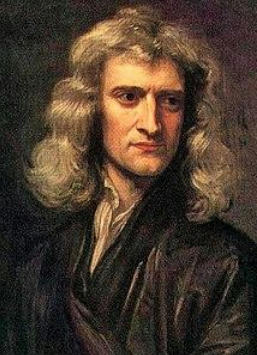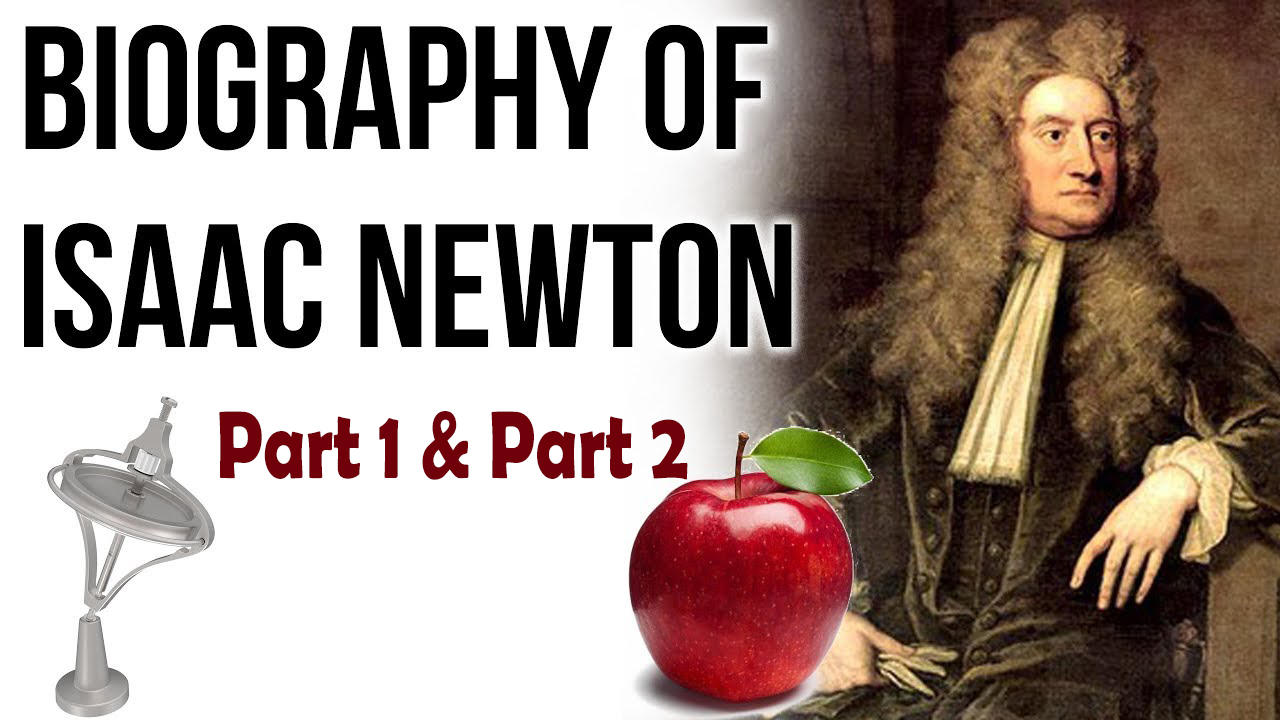Table of Contents
ISAAC NEWTON
PART 1
EARLY LIFE

- Isaac Newton was born on Christmas Day, 25 December 1642 in the county of Lincolnshire. His father, also named Isaac Newton, had died three months before.
- When Newton was three, his mother remarried and went to live with her new husband, leaving her son in the care of his maternal grandmother.
- From the age of about twelve until he was seventeen, Newton was educated at The King’s School, Grantham, which taught Latin and Greek .
- His mother, widowed for the second time, attempted to make him a farmer, an occupation he hated.
EDUCATION
- In June 1661, he was admitted to Trinity College, Cambridge, At that time, the college’s teachings were based on those of Aristotle, whom Newton supplemented with modern philosophers such as Descartes, and astronomers such as Galileo and Thomas Street, through whom he learned of Kepler’s work.
- In 1665, he discovered the generalised binomial theorem and began to develop a mathematical theory that later became calculus. Soon after Newton had obtained his BA degree in August 1665, the university temporarily closed as a precaution against the GreatPlague.
- Although he had been undistinguished as a Cambridge student,Newton’s private studies at his home over the subsequent two years saw the development of his theories on calculus,optics, and the law of gravitation.
CALCULUS
- In April 1667, he returned to Cambridge and in October was elected as a fellow of Trinity.He was elected a Fellow of the Royal Society (FRS) in 1672.
- Newton’s work has been said “to distinctly advance every branch of mathematics then studied”. Newton later became involved in a dispute with Leibniz over priority in the development of calculus.
- Newton had been reluctant to publish his calculus because he feared controversy and criticism. The dispute then broke out in full force in 1711 when the Royal Society proclaimed in a study that it was Newton who was the true discoverer and labelled Leibniz a fraud.
PRINCIPIA MATHEMATICA
- Newton suffered a mental breakdown in 1675 and was still recovering through 1679. In response to a letter from Hooke, he suggested that a particle, if released, would spiral in to the center of the Earth.
- Hooke wrote back, claiming that the path would not be a spiral, but an ellipse. Newton, who hated being bested, then proceeded to work out the mathematics of orbits.
- Again, he did not publish his calculations. Halley, who had become interested in orbits, finally convinced Newton to expand and publish his calculations. Newton devoted the period from August 1684 to spring 1686 to this task, and the result became one of the most important and influential works on physics of all times, Philosophiae Naturalis Principia Mathematica (Mathematical Principles of Natural Philosophy) (1687), often shortened to Principia Mathematica or simply “the Principia.”
PRINCIPIA MATHEMATICA
- In Book I of Principia, Newton opened with definitions and the three laws of motion now known as Newton’s laws .Book II presented Newton’s new scientific philosophy which came to replace Cartesianism.
- Finally, Book III consisted of applications of his dynamics, including an explanation for tides and a theory of lunar motion.
- Newton’s equations also described the motion of Moon by successive approximations, and correctly predicted the return of Halley’s Comet.
OPTICS
- In 1666, Newton observed that the spectrum of colours exiting a prism in the position of minimum deviation is oblong, the prism refracts different colours by different angles.This led him to conclude that colour is a property intrinsic to light—a point which had been debated in prior years.
- From 1670 to 1672, Newton lectured on optics.During this period he investigated the refraction of light, demonstrating that the multicoloured spectrum produced by a prism could be recomposed into white light by a lens and a second prism.
OPTICS
- From this work, he concluded that the lens of any refracting telescope would suffer from the dispersion of light into colours (chromatic aberration).
- As a proof of the concept, he constructed a telescope using reflective mirrors instead of lenses as the objective to bypass that problem.
- Building the design, the first known functional reflecting telescope, today known as a Newtonian telescope,involved solving the problem of a suitable mirror material and shaping technique.
- In late 1668, he was able to produce this first reflecting telescope. It was about eight inches long and it gave a clearer and larger image. In 1671, the Royal Society asked for a demonstration of his reflecting telescope.
OPTICS
- When Robert Hooke criticised some of Newton’s ideas, Newton was so offended that he withdrew from public debate.
- Newton argued that light is composed of particles or corpuscles, which were refracted by accelerating into a denser medium.
- However, later physicists favoured a purely wavelike explanation of light to account for the interference patterns and the general phenomenon of diffraction. Today’s quantum mechanics, photons and the idea of wave–particle duality bear only a minor resemblance to Newton’s understanding of light.
- In 1704, Newton published Opticks, in which he expounded his corpuscular theory of light. He considered light to be made up of extremely subtle corpuscles, that ordinary matter was made of.
ISAAC NEWTON
PART 2
CONFLICTS WITH OTHER SCIENTISTS
-
- Not everyone at the Royal Academy was enthusiastic about Newton’s discoveries in optics .Among the dissenters was Robert Hooke, one of the original members of the Royal Academy and a scientist who was accomplished in a number of areas, including mechanics and optics.
- While Newton theorized that light was composed of particles, Hooke believed it was composed of waves. Hooke quickly condemned Newton’s paper in condescending terms, and attacked Newton’s methodology and conclusions.
- Hooke was not the only one to question Newton’s work in optics. Renowned Dutch scientist Christiaan Huygens and a number of French Jesuits also raised objections.
CONFLICTS WITH OTHER SCIENTISTS
- But because of Hooke’s association with the Royal Society and his own work in optics, his criticism stung Newton the worst. Unable to handle the critique, he went into a rage—a reaction to criticism that was to continue throughout his life.
- Newton denied Hooke’s charge that his theories had any shortcomings and argued the importance of his discoveries to all of science. In the ensuing months, the exchange between the two men grew more acrimonious, and soon Newton threatened to quit the society altogether.
CONFLICTS WITH OTHER SCIENTISTS
- The rivalry between Newton and Hooke would continue for several years thereafter. Then, in 1678, Newton suffered a complete nervous breakdown and the correspondence abruptly ended.
- During his hiatus from public life, Newton returned to his study of gravitation and its effects on the orbits of planets.
- In a 1679 letter of general correspondence to Royal Society members for contributions, Hooke wrote to Newton and brought up the question of planetary motion, suggesting that a formula involving the inverse squares might explain the attraction between planets and the shape of their orbits.
BREAKTHROUGHS
- In August 1684, Halley traveled to Cambridge to visit with Newton, who was coming out of his seclusion. Halley idly asked him what shape the orbit of a planet would take if its attraction to the sun followed the inverse square of the distance between them (Hooke’s theory).
- Newton knew the answer, due to his concentrated work for the past six years, and replied, “An ellipse.” Halley persuaded him to work out the problem mathematically and offered to pay all costs so that the ideas might be published, which it was, in Newton’s Principia.
- Upon the publication of the first edition of Principia in 1687, Robert Hooke immediately accused Newton of plagiarism, claiming that he had discovered the theory of inverse squares and that Newton had stolen his work..
BREAKTHROUGHS
- Newton, however, was furious and strongly defended his discoveries. Halley, who had invested much of himself in Newton’s work, tried to make peace between the two men.
- Principia was published, in 1687. As Newton’s reputation and fame grew, Hooke’s declined, causing him to become even more bitter and loathsome toward his rival.
NEWTON
- Following the publication of Principia, Newton was ready for a new direction in life. He helped lead the resistance to King James II’s attempts to reinstitute Catholic teaching at Cambridge, and in 1689 he was elected to represent Cambridge in Parliament.
- While in London, Newton acquainted himself with a broader group of intellectuals and became acquainted with political philosopher John Locke.
- However, within a few years, Newton fell into another nervous breakdown in 1693. The cause is open to speculation: his disappointment over not being appointed to a higher position by England’s new monarchs.
MEMBER OF PARLIAMENT
- He also devoted a great deal of time to alchemy.Newton was also a member of the Parliament of England for Cambridge University in 1689–90 and 1701.
- Newton moved to London to take up the post of warden of the Royal Mint in 1696.He took charge of England’s great recoining, Newton became perhaps the best-known Master of the Mint upon, a position Newton held for the last 30 years of his life.
- Counterfeiting was high treason, punishable by the felon being hanged, drawn and quartered. Despite this, convicting even the most flagrant criminals could be extremely difficult. However, Newton proved equal to the task.
PRESIDENT OF ROYAL SOCIETY
- In 1703, Newton was elected president of the Royal Society upon Robert Hooke’s death. In 1705, in a controversy that had been brewing for several years, German mathematician Gottfried Leibniz publicly accused Newton of plagiarizing his research, claiming he had discovered infinitesimal calculus several years before the publication of Principia.
- That same year, in another of Newton’s more flagrant episodes of tyranny, he published without permission the notes of astronomer John Flamsteed.
LATER LIFE
- Toward the end of this life, Newton lived at Cranbury Park, near Winchester, England, with his niece, Catherine (Barton) Conduitt, and her husband, John Conduitt.
- By this time, Newton had become one of the most famous men in Europe. His scientific discoveries were unchallenged. He also had become wealthy, investing his sizable income wisely and bestowing sizable gifts to charity.
- Despite his fame, Newton’s life was far from perfect: He never married or made many friends, and in his later years, a combination of pride, insecurity and side trips on peculiar scientific inquiries led even some of his few friends to worry about his mental stability.
DEATH
- By the time he reached 80 years of age, Newton was experiencing digestion problems and had to drastically change his diet and mobility.
- In March 1727, Newton experienced severe pain in his abdomen and blacked out, never to regain consciousness. He died the next day, on March 31, 1727, at the age of 84.
























 WhatsApp
WhatsApp